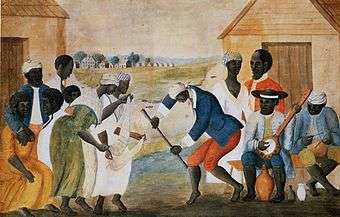Abby Aldrich Rockefeller Folk Art Museum
| Established | 1957 |
|---|---|
| Location | Williamsburg, Virginia |
| Coordinates | 37°09′16″N 76°24′57″W / 37.1545°N 76.4159°W |
| Website | http://history.org/history/museums/abby_art.cfm |
The Abby Aldrich Rockefeller Folk Art Museum is a museum located in Colonial Williamsburg, Virginia, United States. Initially based on donations from Abby Aldrich Rockefeller, it was founded in 1957 and then subsequently expanded to contain a much higher number of objects of folk art. Today it includes more than 3,000 objects.
History
In 1935 philanthropist Abby Aldrich Rockefeller, wife of John D. Rockefeller Jr., founder of Colonial Williamsburg, lent a portion of her folk art collection to the Ludwell-Paradise House in Williamsburg.[1] Four years later, she donated such collection, which remained in the Ludwell-Paradise House until 1956.[2]
In 1956, two years after it had been announced that a museum bearing the Rockefeller name would be built in Williamsburg, David Rockefeller, Abby's son, reunited the collection of the Ludwell-Paradise House to 54 additional folk art objects, which Mrs. Rockefeller had donated to the Metropolitan Museum of Art and the Museum of Modern Art.[2]
The museum opened its doors in May 1957 as the Abby Aldrich Rockefeller Folk Art Collection. It changed names in 1977 to the Abby Aldrich Rockefeller Folk Art Center and again in 2000 as Abby Aldrich Rockefeller Folk Art Museum.[2]
Collection
The 424 objects, collected by Abby Rockefeller between 1929 and 1942 remain the core of the collection, however the museum has grown into containing more than 3,000 objects today.[2]

The first year after its opening the museum came to include, besides Rockefeller's collection, works assembled by J. Stuart Halladay and Herrell Thomas, Holger Cahill, Edith Gregor Halpert, and John Law Robertson. Now the museum contains works of portraiture, Southern and African American folk art, sculpture, fraktur, and textiles. It includes representative works of well renowned artists, such as Eddie Arning, Wilhelm Schimmel, Erastus Salisbury Field, Edward Hicks, Lewis Miller, Albert Hoffman, Louis Joseph Bahin and Ammi Phillips. Various exhibitions of the museum regarded 18th and 19th-century painters such as Zedekiah Belknapp, James Sanforth Elsworth, and Asabel Lynde Powers.[2]
The museum includes notable 18th-century watercolor paintings such as The Old Plantation, by South Carolina slave owner John Rose.[3]
One of the most notable curators of the museum has been Thomas N. Armstrong III.
References
- ↑ Gerard C.Wertkin and Lee Kogan, eds., Encyclopedia of American Folk Art (New York: Routledge, 2004), 1, http://www.questia.com/read/110904768
- 1 2 3 4 5 Gerard C. Wertkin; Lee Kogan; American Folk Art Museum (2004). Encyclopedia of American folk art. Taylor & Francis. pp. 1–2. ISBN 978-0-415-92986-8. Retrieved 14 August 2011.
- ↑ Epstein, Dena J. (September 1975), "The Folk Banjo: A Documentary History", Ethnomusicology, Society for Ethnomusicology, 19 (3), p. 375, doi:10.2307/850790, JSTOR 850790
| Wikimedia Commons has media related to Paintings in the Abby Aldrich Rockefeller Folk Art Museum. |
Further reading
- Abby Aldrich Rockefeller Folk Art Center (1981). American folk portraits: paintings and drawings from the Abby Aldrich Rockefeller Folk Art Center. New York Graphic Society. ISBN 978-0-8212-1100-7. Retrieved 14 August 2011.
- Abby Aldrich Rockefeller Folk Art Center; Beatrix T. Rumford; Carolyn J. Weekley (April 1989). Treasures of American folk art from the Abby Aldrich Rockefeller Folk Art Center. Little, Brown in association with the Colonial Williamsburg Foundation. ISBN 978-0-8212-1726-9. Retrieved 14 August 2011.